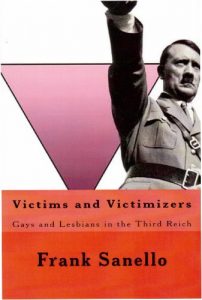Author and journalist Frank Sanello explores the lives of homosexuals in the Third Reich and the democratic Weimar Republic that preceded it.
While lesbians were mostly tolerated in Hitler's Germany, gay males were sent to concentration camps where they were more brutally treated than Jewish inmates.
Ironically, despite Nazi Germany's official condemnation of homosexuality, many prominent Nazis were also gay men. The most prominent was Ernst Röhm, the brutal leader of the Stormtroopers who was murdered by Hitler because the paranoid dictator incorrectly believed Röhm was plotting to overthrow him, not because Röhm flaunted his homosexuality.
“Victims and Victimizers” begins in trés gay Berlin of the Roaring Twenties, immortalized in the film, "Cabaret."
Gays and lesbians thrived in pre-Nazi Germany much like another minority, German Jews. The Institute for Sex Research, a gay think tank, stood across from the German Reichstag or parliament building. After coming to power in 1933, Hitler closed the institute and burned its invaluable library and records.
Newsreels of Nazi book-burnings by college students are believed to depict the destruction of the institute’s archives.
Gays who couldn’t or wouldn’t flee Nazi Germany paid the ultimately penalty for remaining in a country whose regime hated them as much as the Jews.
An estimated 100,000 gay men were arrested, and 10 percent died in concentration camps, a greater mortality rate than any other group, including Jews. The persecution of those who survived didn’t end with the war. After the liberation of the death camps, gays weren’t freed but transferred to traditional prisons. Germany didn’t decriminalize homosexuality until 1994 and never paid reparations to gay survivors as the government did for other survivors.
In “Victims and Victimizers,” Frank Sanello uses his skills as an investigative journalist to uncover the real reason for the Nazi atrocity known as Kristallnacht in 1938, when all of Germany’s synagogues were burned and thousands of Jews murdered or deported to camps. Hitler portrayed Kristallnacht as a reprisal for the assassination of an aristocratic Nazi diplomat by a Polish-German Jew at the German embassy in Paris. But the assassination had nothing to do with Germany’s persecution of the Jews. The Nazi propaganda machine suppressed the fact that the victim and assassin had been lovers and that the murder of the diplomat was the result of a lovers quarrel with his assassin.
The author examines the possibility that Adolf Hitler himself may have had a homosexual affair in Vienna during his teens. After World War II, Hitler’s best friend from that period wrote about their relationship and hinted that it involved sex.
While lesbians were mostly tolerated in Hitler's Germany, gay males were sent to concentration camps where they were more brutally treated than Jewish inmates.
Ironically, despite Nazi Germany's official condemnation of homosexuality, many prominent Nazis were also gay men. The most prominent was Ernst Röhm, the brutal leader of the Stormtroopers who was murdered by Hitler because the paranoid dictator incorrectly believed Röhm was plotting to overthrow him, not because Röhm flaunted his homosexuality.
“Victims and Victimizers” begins in trés gay Berlin of the Roaring Twenties, immortalized in the film, "Cabaret."
Gays and lesbians thrived in pre-Nazi Germany much like another minority, German Jews. The Institute for Sex Research, a gay think tank, stood across from the German Reichstag or parliament building. After coming to power in 1933, Hitler closed the institute and burned its invaluable library and records.
Newsreels of Nazi book-burnings by college students are believed to depict the destruction of the institute’s archives.
Gays who couldn’t or wouldn’t flee Nazi Germany paid the ultimately penalty for remaining in a country whose regime hated them as much as the Jews.
An estimated 100,000 gay men were arrested, and 10 percent died in concentration camps, a greater mortality rate than any other group, including Jews. The persecution of those who survived didn’t end with the war. After the liberation of the death camps, gays weren’t freed but transferred to traditional prisons. Germany didn’t decriminalize homosexuality until 1994 and never paid reparations to gay survivors as the government did for other survivors.
In “Victims and Victimizers,” Frank Sanello uses his skills as an investigative journalist to uncover the real reason for the Nazi atrocity known as Kristallnacht in 1938, when all of Germany’s synagogues were burned and thousands of Jews murdered or deported to camps. Hitler portrayed Kristallnacht as a reprisal for the assassination of an aristocratic Nazi diplomat by a Polish-German Jew at the German embassy in Paris. But the assassination had nothing to do with Germany’s persecution of the Jews. The Nazi propaganda machine suppressed the fact that the victim and assassin had been lovers and that the murder of the diplomat was the result of a lovers quarrel with his assassin.
The author examines the possibility that Adolf Hitler himself may have had a homosexual affair in Vienna during his teens. After World War II, Hitler’s best friend from that period wrote about their relationship and hinted that it involved sex.






